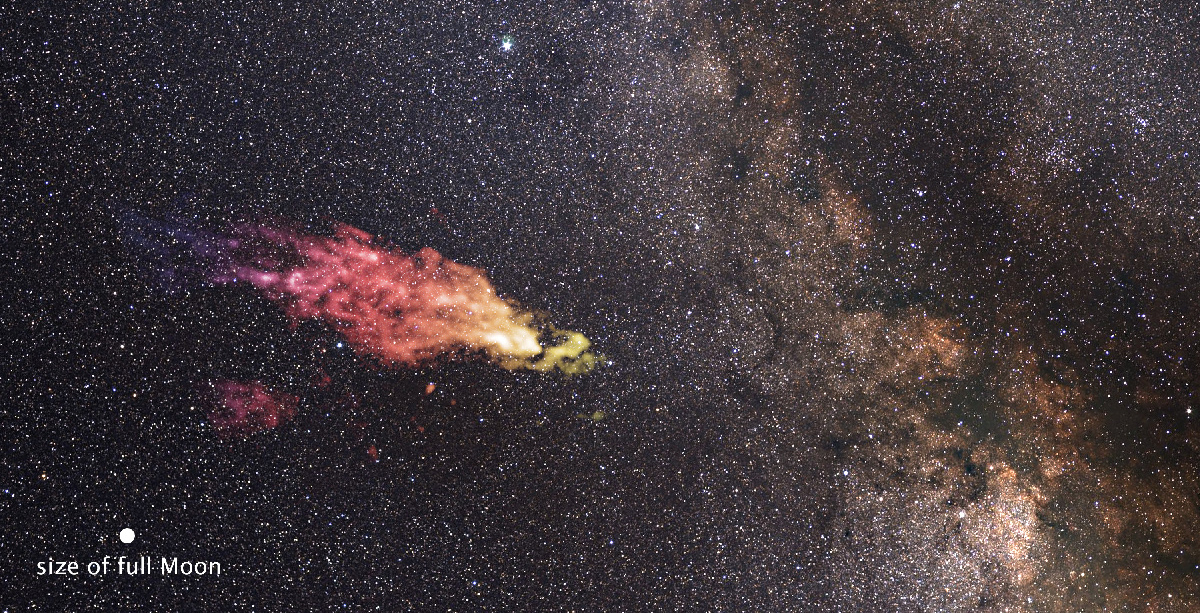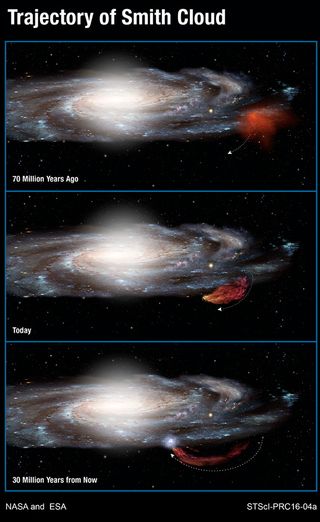Gas Cloud Flung Out of Milky Way Is Coming Back for Revenge

This time, it's personal. A massive cloud ejected from the outskirts of the Milky Way galaxy about 70 million years ago is now hurtling back toward the disk at breakneck speed.
The boomeranged collection of gas, known as Smith's Cloud, was discovered in 1963, and scientists say it will collide with the Milky Way in about 30 million years. But a new study looking the composition of the cloud shows that it shares a similar chemical signature as the outer disk of the Milky Way.
Smith's Cloud is 11,000 light-years long by 2,500 light-years wide (for comparison, the Milky Way is about 100,000 light-years in diameter), and is speeding toward the Milky Way at nearly 700,000 miles per hour. While it is invisible to the naked eye, if humans could see it in the night sky, it would appear to be about 30 times the size of the full moon, according to NASA. [Stunning Photos of Our Milky Way Galaxy (Gallery)]
To determine the cloud's composition, the authors of the new research used NASA's Hubble Space Telescope. As light from background galaxies passes through the cloud, certain chemical elements inside the cloud absorb the light in specific wavelengths. The dips in brightness reveal which elements are present within the cloud. The researchers looked for sulfur, which provides a good gauge of how many elements heavier than hydrogen and helium are contained by the object.
"By measuring sulfur, you can learn how enriched in sulfur atoms the cloud is compared to the sun," lead author Andrew Fox, of the Space Telescope Science Center in Baltimore, said in a statement from the University of Notre Dame, where one of his co-authors is based.

Fox and his colleagues found that the cloud is as rich in sulfur as the outer disk of the Milky Way, a region filled with material created by stars and spread when they exploded into supernovas. This region is about 40,000 light-years from the galactic center.
If the starless cloud originated from the depths of space, as some have proposed, it would contain only hydrogen and helium. The new study reveals that upon collision, the fresh supply of gas should kick-start star formation in the galaxy. It contains enough gas to generate two million suns, according to the statement.
Get the Space.com Newsletter
Breaking space news, the latest updates on rocket launches, skywatching events and more!
"We have found several massive clouds in the Milky Way halo that may serve as future fuel for star formation in its disk, but, for most of them, their origins remain a mystery," said Nicolas Lehner, of the University of Notre Dame, in the statement. "The Smith Cloud is certainly one of the best examples that shows that recycled gas is an important mechanism for the evolution of galaxies."
The research was published in the Astrophysical Journal Letters.
Follow Nola Taylor Redd on Twitter @NolaTRedd or Google+. Follow us at @Spacedotcom, Facebook or Google+. Originally published on Space.com.
Join our Space Forums to keep talking space on the latest missions, night sky and more! And if you have a news tip, correction or comment, let us know at: community@space.com.

Nola Taylor Tillman is a contributing writer for Space.com. She loves all things space and astronomy-related, and enjoys the opportunity to learn more. She has a Bachelor’s degree in English and Astrophysics from Agnes Scott college and served as an intern at Sky & Telescope magazine. In her free time, she homeschools her four children. Follow her on Twitter at @NolaTRedd











